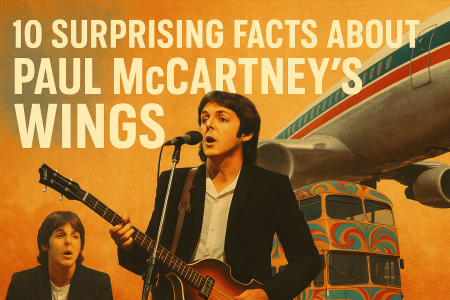Wings was more than just Paul McCartney’s post-Beatles project—it was a daring musical adventure. Formed in 1971 with his wife Linda McCartney and Moody Blues’ guitarist Denny Laine, Wings faced its fair share of criticism, chaos, and charm. Yet amid the arena tours and platinum records lies a lesser-told story—one built on strange mishaps, bold moves, and unexpected collaborators. Here are 10 facts about Wings that fly under most radars.
1. Their Tour Bus Looked Like a Moving Art Installation
While other bands chartered planes or sleek coaches, Wings hit the road in 1972 with a psychedelic double-decker bus. It wasn’t just for show—this rolling home included beds, a kitchen, and space for the McCartney kids. The idea was to turn touring into a family affair, though the vintage bus’s slow pace and constant mechanical hiccups made it a logistical nightmare.
2. A Violent Robbery Shaped One of Their Greatest Albums
While recording Band on the Run in Lagos, Nigeria, Paul and Linda were mugged at knifepoint. The assailants made off with a cassette of demo recordings and handwritten lyrics—forcing McCartney to recreate much of the album from memory. It was a setback that could have wrecked the project, but instead, it fueled one of Wings’ most iconic records.
3. Fela Kuti Didn’t Take Kindly to Their Presence in Nigeria
McCartney’s decision to record in Africa didn’t go unnoticed by Fela Kuti, the Afrobeat legend. Kuti initially accused Wings of planning to exploit African music. Paul, hoping to clear the air, invited him to hear their tracks. After listening, Kuti reportedly agreed there was no cultural theft involved. Still, the incident revealed the complexities of cross-cultural music ventures.
4. “Jet” Was Named After the Family Dog
Many fans have speculated about the meaning behind the song “Jet,” with theories ranging from politics to metaphors for freedom. The truth? It’s far simpler. The title came from the McCartney family’s black Labrador Retriever, Jet. According to Paul, the song evolved after the name stuck in his head during recording sessions.
5. Wings Attempted a ‘Lost’ Album—More Than Once
Over the years, McCartney tried multiple times to compile an album of unreleased Wings tracks. Dubbed Cold Cuts, the project was revisited in different forms between the late ’70s and early ’80s but never officially saw the light of day. Bootlegs and fan speculation kept the myth alive, but the album remains one of rock’s great what-ifs.
6. A “Non-Album” Became a Cult Classic
In 1974, Wings recorded a loose studio session called One Hand Clapping at Abbey Road Studios. Originally intended as a promotional film, the recordings weren’t released commercially for decades. Bootleg copies circulated among collectors for years before an official release finally gave the session the attention it deserved. It’s now considered one of the best behind-the-scenes snapshots of the band’s chemistry.
7. A Charity Gig Ended Up Harming Venice
In a strange twist of fate, a 1976 Wings concert in St. Mark’s Square—organized to raise funds for Venice’s preservation—may have caused structural damage. The stage setup and vibrations reportedly compromised the ancient paving. Despite the good intentions, the show turned into a cautionary tale about bringing rock and roll to fragile historical sites.
8. Ginger Baker Lent a Hand—and a Tin Can
While recording in Nigeria, Wings accepted an invitation to Ginger Baker’s ARC Studio. The former Cream drummer offered more than just hospitality; he played percussion on “Picasso’s Last Words (Drink to Me),” famously using a tin filled with gravel as an instrument. It was an odd but fitting contribution to one of the album’s quirkiest tracks.
9. The ‘Wings Over America’ Cover Was a Visual Standout
Wings’ massive 1976 live album Wings Over America wasn’t just sonically ambitious—it looked the part too. Designed by the famed studio Hipgnosis, known for Pink Floyd’s visuals, the cover art featured a stylized airplane door cracking open mid-flight. The design earned a Grammy nomination and cemented the album as a visual as well as musical statement.
10. “Silly Love Songs” Was Paul’s Snarky Comeback
Critics often slammed McCartney for writing what they called “frivolous” music. In 1976, he answered back with “Silly Love Songs,” a track that embraced the criticism and turned it into a chart-topping hit. With a cheeky wink, Paul reminded everyone that writing love songs—especially ones that sell millions—is nothing to scoff at.
